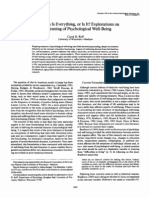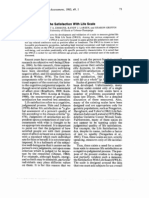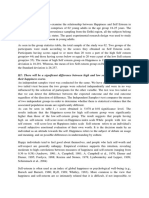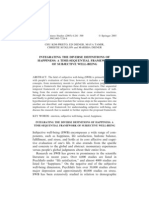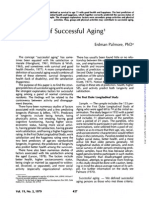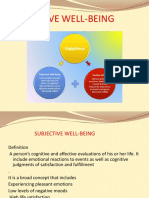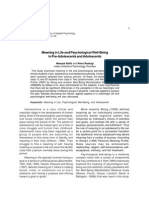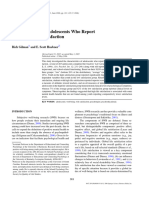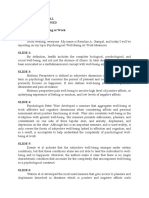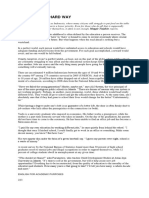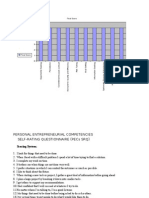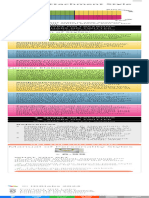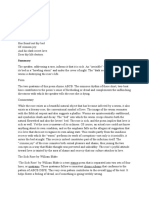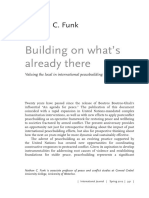The Satisfaction With Life Scale: Journal of Personality Assessment
The Satisfaction With Life Scale: Journal of Personality Assessment
Uploaded by
Naneun NabilahCopyright:
Available Formats
The Satisfaction With Life Scale: Journal of Personality Assessment
The Satisfaction With Life Scale: Journal of Personality Assessment
Uploaded by
Naneun NabilahOriginal Description:
Original Title
Copyright
Available Formats
Share this document
Did you find this document useful?
Is this content inappropriate?
Copyright:
Available Formats
The Satisfaction With Life Scale: Journal of Personality Assessment
The Satisfaction With Life Scale: Journal of Personality Assessment
Uploaded by
Naneun NabilahCopyright:
Available Formats
Journal of Personality Assessment, 1985,49, 1
The Satisfaction With Life Scale
ED DIENER, ROBERT A. EMMONS, RANDY J. LAR.SEM, and SHARON GRIFFIN University of Illinois at Urbana-Champaign
Abstract: This article reports the development and validation of a scale to measure global life satisfaction, the Satisfaction With Life Scale (SWLS). Among the various components of subjective well-being, the SWLS is narrowly focused to assess global life satisfaction and does niot tap related constructs such as positive affect or loneliness. The SWLS is shown to have favorable psychometric properties, including high internal consistency and high temporal reliability. Scores on the SWLS correlate moderately to highly with other measures of subjective well-being, and correlate predictably with specific personality characteristics. It is noted that the S W ~ 1s S suited for use with different age groups, and other potential uses of the scale are discussed.
Recent years have seen an increase in research on subjective well-being (Diener, 1984). In this research, three separable components of subjective well-being have been identified: positive affect, negative affect, and life satisfaction (Andrews & Withey, 1976). The first two compodents refer to the affective, emotional aspects of the construct; the latter to the cognitive-judgmental aspects, A1though several scales for the assessment of affect exist (Bradburn, 1969; Kammann & Flett, 1983; Kozma & Stones, 1980), the measurement of general life satisfaction has received less attention. Life satisfaction refers to a cognitive, judgmental process, Shin and Johnspn (19'78) define life satisfaction as "a global assessment of a person's quality of life according to his chosen criteria" (p. 478). Judgments of satisfaction are dependent upon a comparison of one's circumstances with what is thought to be an appropriate standard. It is important to point out that the judgment of how satisfied people are with their present state of affairs is based on a comparison with a standard which each individual sets for him or herself; it is not externally imposed. It is a hallmark of the subjective well-being area that it centers on the person's own judgments, not upon some criterion which is jpdged to be importanr by the researcher (Dienes, 1984). For example, although health, energy, and so forth may be desirable, particular individuals may place different values on them. It is far this reason that ive
need to ask the person for their overall evaluation of their life, rather than summing across their satisfaction wit11 specific domains, to obtain a measure of overall life satisfaction. As Tatarkiewicz (1976) wrote, ". ..happiness requires total satisfaction, that is satisfiiction with life as a whole" (p. 8). Scales of general life satisfaction have been, developed. Unfortunately, many of these scales consist only of a single item. Such single item scales have a number of problems associated with them (see Diener, 1984, for a detailed discussion of these measures). Also, many of the existing scales have been designed and are appropriate only for geriatric populations, such as Neugarten, Havighurst, and Tobin's (1961) Life SatPhilaisfaction Index and LawtonYs(l975) delphia Geriatric Center Morale Scale. Furthermore, many of these scalles do not appear to be tapping solely the judgmental quality of life satisfaction. For example, the Life Satisfaction Index, despite its name, includes a factor of zest vs. apathy (Neugarten ~:t al., 1961). Thus, these scales are not, strictly speaking, measures only of life. saitisfaction, Thus, there exists a need for a ]multiitem scale to measure life satisfaction as a cognitive-judgmental process. The purpose of the present studies is to design and partially validate such a measure, the Satisfaction With Life Scale (SINLS). The scale is designed around the idea that one mmt ask subjects for an oiverall
72 judgment of their life in order to measure the concept of life satisfaction. Study 1 In the initial phase of scale co.nstruction, a list of 48 self-re~ort items were generated. These consisied primarily of questions related to satisfaction with one's life; however, some positive and negative affect items were included. Inr resulted in three facitial f a c t ~analyses tors: pssitive affect, negative affect, and satisfaction. The affect items were eliminated, as were items from the satisfaction factor that had loadings less than .60, and 10 items were left. Because of the high semantic similarity of several of those items, five were dropped, resulting in a five-item scale, the SWLS. Study 1 was designed to te$t the psychometric properties of the scale. Method Subjects were 176 undergraduates at the University of Illinois who were enrolled in introductory psychology classes. Subjects were administered the SWLS in a group setting. Two months later, 76 of these students were readministered the s'cale. Results The mean score on the SWLS was 23.$, with a standard deviation of 6.43. Each itern is scored from 1 to 7, so the possible range of scores on the questionnaire is from 5 (low satisfaction) to 35 (high satisfaction). The two-month testretest correlation coefficient was .82, and coefficient alpha was .87. The interitern correlation matrix was factor anal y z ~ dusing , principal axis factor analysis. The number of factors to be extracted was determined by an inspection of the scree plot of eigenvalues. Using this criterion, a single factor emerged, accounting for 66% of the variance. The SWLB items and their respective factor loadjn$s are presented in Table 1, along with the item-total correlation for each itiem. Having shown that the SWLS has desirable psychometric properties, the next step was to examine the relationship be-
The Satisfaction with Life Scale
Table l SWLS Items and Factor Loadings Item 1. In most ways my life is close to my ideal. 2. The conditions of my life are excellent. 3. Ia m satisfied with my life 4. S o far I have gotten the important things I want inlife. 5. If Icould live my life over, I would change almost nothing. ItemFactor Total Loadings Correlations
.84
.77 .83 .72
.75
.69 .75
.67
.61
.57
Note: n = 176. SWLS = Satisfaction With Life Scale. Instructions for administering the scale are: Below are five statements with which you may agree or disagree. Using the 1-7 scale below, indicate your agreement with each item by placing the appropriate number on the line preceding that item. Please be open and honest in your responding. The 7-point scale is: 1=strongly disagree, 2 = disagree, 3 = slightly disagree, 4 = neither agree nor disagree, 5 =slightly agree, 6 =agree, 7 =strongly agree.
tween it and other measures of subjective well-being, and also with certain personality measures to which we might expect it to be related. Method Two different samples of undergraduates served as subjects. Sample 1 consisted of the 176 students used in Study 1. Sample 2 consisted of a different group of 163 undergraduates enrolled in introductory psychology classes. In addition to the SWLS, subjects were also administered a battery of subjective wellbein measures. These included: Cantril's (1968 $elf-Anchoring Ladder, Gurin et a1.L (1960) widely used item, Andrews and Withey's (1976) D-T scale, and Fordyce's (1978) single item measure of happiness, Fordyce's (1978) percent of time happy question, Campbell, Converse, and Rodgers'(1976) semantic differential-like scale, Bradburn's (1969) Affect Balance Scale, Tellegen's (1979)
E. DIENER, R. A. EMMONS, R. J. LARSEN, and S. GRIFFIN
Table 2 Correlations Between the S W L S a n d of Subiective Well-Being Other Meas~rres
Sample 1 Sample 2 ( n = 176) ( n = 163)
73
Fordyce 1 Fordyce (percent)
DPQ
Cantril Gurim Andrews and Withey Campbell Bradburn-PAS Bradburn-NAS Sum~med Domain Satisf. AIM Note: DPQ = Differential Personality Questionnaire. PAS = Positive Affect Scale. NAS = Negative Affect Scale. AIM = Affect Intensity Measure. Sample 2 was not administered the DPQ or the AIM, and Sample 1 did not complete the domain satisfaction items.
are shown in Table 2. In both samples there are moderately strong correlations with all of the subjective well-being scales except the AIM, which is a measure of the intensity of emotional experience. The correlations for Sample 2 between scores 011 the SWLS and scares on the selected1 personality measures were self-esteem~, .54; symptom checklist, -.41; neuroticism, -.48; emotionality, -.25; activity, .08; sociability, 20; and impulsivity, -.03. It appears that individuals who are satisfied with their lives are in general well adjusted and free from psychopatho~logy. Study 3 Both studies above were: limited to college student populations. I n the present study we assessed the psychometric properties of the SWLS on a geriatric population. In addition, we obtained a criterion validity coefficient for the S WLS in terms of a life satisfaction rating ]made by experimenters who interviewed each subject about their life. Method Fifty-three elderly persons living in the Urbana-Champaign area voluntisered for the project. There were four nnajor groups of subjects: those in a nursing home, shut-ins, a coffee-group of former businessmen, and a group of religiously oriented women who met together periodically. The average age was 75, and 32 were females. Each participant was interviewed about their life for about one hour by a pair af trained interviewers. Subjects received a structured set of questions which focused on .theextent to which they remained active and were oriented toward self-directed learming. At the end of the session, subjects completed a large print version of the SjWLS and a revision of the Life Satisfaction Index (Adams, 1969). The interviewers independently rated each subject in tlerms of glabal life satisfaction on a 7-point scale. Results The mean SWLS score for the sample was 25.8. The ratings of the two inter-
well-being subscale of his Differential Personality Questionnaire, and Larsen's (1983) Affect Intensity Measure (AIM). Sample 2 was also given Buss and Plomin's (1975) survey of the temperaments (EASI-111), the Rosenberg (1965) SelfEsteem Scale, the Neuroticism scale of the Eysenck IPersonality Inventory (Eysenck & Eysenck, 1964), a symptom checklist similar to the Hopkins inventory (Derogatis, Lipman, Rickels, & Plomin, 1974), ratings of life satisfaction in 10 key life domains (e,g., grades, health, love life, and friends), and the Marlowe-Crowne (Crowne & Marlowe, 1964) scale of social desirability. The 10 life domain questions simply asked subjects to rate each of these areas of their life. These ral.ings were then summqd in an unweighted way to yield a domain score. satisfaction c~omposite Results Scores on the SWLS correlated .02 with the Marlowe-Crowne measure, indicating that the SWLS is not evoking a social desirability response set. The correlations between the SWLS and the other measures of subjective well-being
74 viewers correlated .73 and were summed to create a rater life satisfaction composite judgment. This value correlated .43 with the SWLS. The LSI and the SWLS correlated -46 and the LSI and interviewer composite correlated .68. The item-total correlations for the five SWLS items were: 3 1 , .63, .61, .75, and .66, again showing a good level of internal consistency for the scale. Discussion The results indicated that the scale has favorable psychometric properties. indiThe correlations with ~ersonalitv cators of well-being disiussed in study 2 suggest that the scale might be useful in clinical 'seittin@*The correlation of .57 with summed domain satisfactions indicates that global satisfaction and domain satisfactions share a good deal of but certainly are not common vari~nce, equivalent constructs. The SWLS correlated at an adequate level with interviewer estirnhtas of life: satisfaction. A question arises about why the interviewer ratings correlated mlore highly with the LSI than with the SWLS. The LSI is a broader bandfinstrumentthat includes affe~tive as weXl$ I; life eatisfaction content. It appears that the interviewer ratings wen also influendad by such affective cbnteat and thus correlated more highly uiiiieb, thB LSI. The narrow band characteir af eha SWLS is supported by the firrdfpp$ of Laraem, Diener, aad Emrnansi 1(1,9$3$1 rwhich showed that the SWL%showad weaker orr relations with a f f e ~thph t did ather measures of subjective we1lkbe;ing. Future zpslaprch needs t o establish the discriminlant validity of the scale, and should &\soexplore in more depth the relationship between affect and life satisfactibn, as well as the relationship between,life 'rllaYPsfactionand domain satisfqctiads. M'nlikd other scales, the SWLS leave$ tip r~spondentfree to weight variaps djbr$l@i;llns (e.g., heialth or material wealth) and various feeling states (e,g., loneliness) in whatever way he or she chooses.
The Satisfaction with Life Scale
References Adams, D. L. (1969). Analysis of a life satisfaction index. Journal of Gerontology, 24, 470-474. Andrews, F. M., & Withey, S. B. (1976). Social indicators of well-being: America's perception o f life quality. New York: Plenum. Bradburn, N. M. (1969). The structure ofpsychological well-being. Chicago: Aldine. Buss, A. H., & Plomin, R. (1975). A temperament theory of personality development. New York: Wiley . Campbell, A., Converse, P. E., & Rodgers, W. L. (1976). The quality of American life. NewYork: Russell Sage. Cantril, H. (1965). Thepatterns ofhuman concern. New Brunswick, NJ: Rutgers University Press. Crowne, D. P., & Marlowe, D. (1964). Theapproval motive. New York: Wiley. Derogatis, L. R., Lipman, R. S., Rickels, J., & Covi, L. (1974). The Hopkins Symptom Checklist: A measure of primary symptom dimensions. In P. Pichot (Ed.), Psychological measurements in psychopharmacology: Modern problems in pharmacopsychiatry. Basel, Switzerland: S. Kraeer. " Diener, E. (1984). Subjective well-being. Psychological Bulletin, 95, 542-575. Eysenck, H. J.,& Eysenck, S. B. G. (1964). Manual of the' EysenckpersonalEty invenrory, San Diego, CA: Educational and Industrial Testing Service. Fordgce, M. W. (1978). Prospectus: The selfdescription inventory. Unpublished paper, Edison Community College, Ft. Myers, FL. Gurin, G.,Veroff, J., & Feld, S. (1960). American's view of their mental health. New York: Basic Books. Kaamann, R., & Flett, R. (1983). Affectometer 2: A scale to measure current level of general happings$. Australiah Journal of Psychology, 35, 257-265. Ko~kna, A., & Stones, M. J. (1980). Tqe measurement of hapdiness: Development ofthe Memorial University of Newfoufldland Scale of Ha piness (MUNSCH). Journol of Gerontology, f5,906912. Larsen, R. J. (1983). Manual for the leffect Intensity Measure. Unpublished manuscript, University of Illinois at Urbana-Champaign. Larsen, R. J., Diener,.E., & Emmons, R. A. (1983). Validity and meaning of measures af subjective well-being. Paper presented at the Midwestern Psychological Association Canvention, Chicago. Lawton, M. P. (1975). The Philadelphia Geriatric Center Morale Scale: A revision. Journal of Gerontology. 30, 85-89. Neugarten, B. L., Havighurst, R. J., &Tobin, S. S. (19161). The measurement of life $atisfaction. Journal of Gerontology, 16, 134-143. Rosqnberg, M. (1965). Society and the adolescent so&-image. Princeton, NJ: Princeton University Press.
E. IDIENER, R. A. EMMONS, R. J. LARSEW, and S. GRIFFIN
Shin, D. C., & Johnson, D. M. (1978). Avowed happiness as an overall assessment of the quality of life. Social Indicators Research, 5, 475-492. Tatarkiewicz, W. (1976). Analysis of-happiness. The Hague, Netherlands: Martinus Nijhoff. Tellegen, A. (1979). DSfferentialpersonaZityquestionnaire. Unpublished materials, University of Minnesota.
Ed Diener Department of Psychology University of Illinois 603 E. Daniel Champaigll9 IL 61820
~$~~~d$~y"~~';~,2' 19"
You might also like
- The Satisfaction With Life Scale and The Emerging Construct of Life SatisfactionDocument17 pagesThe Satisfaction With Life Scale and The Emerging Construct of Life Satisfactiondrathore55No ratings yet
- Lesson Plan in Applied Economics Semi Detailed FinalDocument4 pagesLesson Plan in Applied Economics Semi Detailed FinalLani N Flores100% (10)
- Happiness Is Everything, or Is It Explorations On The Meaning of Psychological Well-BeingDocument13 pagesHappiness Is Everything, or Is It Explorations On The Meaning of Psychological Well-BeingKiklefou100% (2)
- Satisfaction With Life Scale: ReferenceDocument8 pagesSatisfaction With Life Scale: ReferencetotalnocoolNo ratings yet
- Walt DisneyDocument56 pagesWalt DisneyDaniela Denisse Anthawer Luna100% (7)
- SWLS (SatWithLifeScale)Document5 pagesSWLS (SatWithLifeScale)Jiřina Liliana DoubkováNo ratings yet
- The Satisfaction With Life ScaleDocument6 pagesThe Satisfaction With Life ScaleChiriac100% (1)
- Margolis Et Al - 2019 - A New Measure of Life Satisfaction - RLSSDocument12 pagesMargolis Et Al - 2019 - A New Measure of Life Satisfaction - RLSSMuhamad Hazim Bin Muhamad Eddin SyazriNo ratings yet
- Theory of Life SatisfactionDocument29 pagesTheory of Life SatisfactionkavipremanNo ratings yet
- Diener Et Al - The Satisfaction With Life ScaleDocument7 pagesDiener Et Al - The Satisfaction With Life ScaleLilu0% (1)
- Neto, ARTIGO, The Satisfaction With Life Scale Psychometrics Properties in An Adolescent SampleDocument10 pagesNeto, ARTIGO, The Satisfaction With Life Scale Psychometrics Properties in An Adolescent SampleCristina BritoNo ratings yet
- JGHJGDocument2 pagesJGHJGNeelu SanghiNo ratings yet
- Pelin Kesebir makale 2Document35 pagesPelin Kesebir makale 2mahmut sansalNo ratings yet
- BradburnScaleofPsychologicWell BeingDocument3 pagesBradburnScaleofPsychologicWell BeingKenny AranasNo ratings yet
- UC Riverside Previously Published WorksDocument21 pagesUC Riverside Previously Published WorksPriscilla FerrufinoNo ratings yet
- Springer Hauser PWB MS SSR 081805Document52 pagesSpringer Hauser PWB MS SSR 081805Jasmin NayakNo ratings yet
- 2009 DienerKesebirTovDocument36 pages2009 DienerKesebirTovkhaddi.kjNo ratings yet
- Well Being Scale FinalDocument28 pagesWell Being Scale Finalmonika abrol100% (1)
- Ed Diener Et Al. 2013 The Theory and Validity of Life Satisfaction Scales SIRDocument31 pagesEd Diener Et Al. 2013 The Theory and Validity of Life Satisfaction Scales SIRPradeep ThawaniNo ratings yet
- Well 6Document17 pagesWell 6Gustavo Adolfo DomínguezNo ratings yet
- IntegracijaDocument41 pagesIntegracijaMirjana SučevićNo ratings yet
- Theory and Validity of Life Satisfaction Scales, 2013Document31 pagesTheory and Validity of Life Satisfaction Scales, 2013kyokun89No ratings yet
- PSYCOLOGYDocument28 pagesPSYCOLOGYrockpunjabi42No ratings yet
- Predictors of Successful AgingDocument5 pagesPredictors of Successful AgingMichael A M DaviesNo ratings yet
- Child Trends-2003 03 12 PD PDConfHSVP PDFDocument33 pagesChild Trends-2003 03 12 PD PDConfHSVP PDFGuillermoNo ratings yet
- Synopsis NewDocument14 pagesSynopsis Newasifaziz.qau.edu.pkNo ratings yet
- Life Satisfaction ScaleDocument7 pagesLife Satisfaction ScaleRue RyuuNo ratings yet
- For Indicators of Positive Development Conference March 12-13, 2003Document33 pagesFor Indicators of Positive Development Conference March 12-13, 2003Ghouri KhanNo ratings yet
- Measuring HappinessDocument22 pagesMeasuring HappinessSree LakshyaNo ratings yet
- Self-Directed Learning Readiness and Life Satisfaction Among Older Adults A Sample Quantitative Research Proposal Written in The APA 5 StyleDocument10 pagesSelf-Directed Learning Readiness and Life Satisfaction Among Older Adults A Sample Quantitative Research Proposal Written in The APA 5 StyleMuhammad FurqanNo ratings yet
- Report of Life Satisfaction ScaleDocument5 pagesReport of Life Satisfaction ScaleAnupriyaNo ratings yet
- Radloff L 1977 ADocument18 pagesRadloff L 1977 AAlina PopaNo ratings yet
- Cahya Fitri - Effectiveness of Mindfulness Based Cognitive Behavior Therapy On LifeDocument5 pagesCahya Fitri - Effectiveness of Mindfulness Based Cognitive Behavior Therapy On Lifenadya ima mustikaNo ratings yet
- REVIEW JURNAL Muhammad Mudzakkir Abdul Hakim 200701502064Document4 pagesREVIEW JURNAL Muhammad Mudzakkir Abdul Hakim 200701502064Abdillah JettaNo ratings yet
- Life SatisfactionDocument30 pagesLife SatisfactionFernanda Morales100% (1)
- Measuring Happiness: Questionnaire in Tips and Techniques in This Happiness Section.)Document3 pagesMeasuring Happiness: Questionnaire in Tips and Techniques in This Happiness Section.)Cariaga RubilarNo ratings yet
- L13 HaworthDocument13 pagesL13 HaworthElias Hinostroza HernándezNo ratings yet
- Research If Assessmnent of Life Satisfaction of Children and AdolescentsDocument32 pagesResearch If Assessmnent of Life Satisfaction of Children and AdolescentsJ. Félix Angulo RascoNo ratings yet
- Self-Directed Learning Readiness and Life Satisfaction Among Older Adults A Sample Quantitative Research Proposal Written in The APA 6 TH StyleDocument12 pagesSelf-Directed Learning Readiness and Life Satisfaction Among Older Adults A Sample Quantitative Research Proposal Written in The APA 6 TH StyleSyahrul HudaNo ratings yet
- Coyne 4 ManuscriptDocument52 pagesCoyne 4 Manuscriptminhot525No ratings yet
- Psycholigal and Physical Wellbeing in The Elderly Well Being Scale (PWB)Document10 pagesPsycholigal and Physical Wellbeing in The Elderly Well Being Scale (PWB)ChenghorNgNo ratings yet
- Subjective Well - BeingDocument18 pagesSubjective Well - Beingfalguni100% (2)
- Tanja Panić: Child Well-Being From The Perspective of ParentsDocument9 pagesTanja Panić: Child Well-Being From The Perspective of ParentsMagdalena BozinoskaNo ratings yet
- Bedah Iskandar Japardi33Document13 pagesBedah Iskandar Japardi33Norvita AsniNo ratings yet
- SubjectiveWell BeingDocument13 pagesSubjectiveWell Beinghafsa fatimaNo ratings yet
- Barrett & Murk Life SatisfactionDocument6 pagesBarrett & Murk Life SatisfactionMaria Gracia Chirinos VasquezNo ratings yet
- SATISFACTION SubjectiveHappinessDocument2 pagesSATISFACTION SubjectiveHappinessAnca UrsacheNo ratings yet
- Hindi Adaptation of Diener S FlourishingDocument4 pagesHindi Adaptation of Diener S Flourishingraveenayadav.02No ratings yet
- Jurnal KesmenDocument8 pagesJurnal KesmenAjenk RamaNo ratings yet
- Likert Scale Rupesh KumarDocument13 pagesLikert Scale Rupesh Kumarrupeshverma491993No ratings yet
- 2an Evaluation of The Precision of Measurement of Ryff'sDocument17 pages2an Evaluation of The Precision of Measurement of Ryff'sRucsandra MurzeaNo ratings yet
- Gilman-Huebner2006 Article CharacteristicsOfAdolescentsWhDocument9 pagesGilman-Huebner2006 Article CharacteristicsOfAdolescentsWhDalma0501No ratings yet
- Psychological Well-Being at Work AbstractDocument6 pagesPsychological Well-Being at Work AbstractGAMPAL, RESYLIZA ACALA. UnknownNo ratings yet
- A Note On The Dimensionality of Quality of Life Scales: An Illustration With The Satisfaction With Life Scale (SWLS)Document8 pagesA Note On The Dimensionality of Quality of Life Scales: An Illustration With The Satisfaction With Life Scale (SWLS)Cristina BritoNo ratings yet
- Study Psychological Well-Being: Peter WarrDocument11 pagesStudy Psychological Well-Being: Peter WarrPatricia ReiNo ratings yet
- Subjectivewellbeing, Psychology Of: December 2015Document8 pagesSubjectivewellbeing, Psychology Of: December 2015Gabriel JulioNo ratings yet
- Well DoneDocument11 pagesWell DoneAbner ogegaNo ratings yet
- Relationship Between Subjective Happiness and Wisdom of Retired ProfessionalsDocument6 pagesRelationship Between Subjective Happiness and Wisdom of Retired ProfessionalsTJPRC PublicationsNo ratings yet
- Positive Psychology - Baumgartner NotesDocument47 pagesPositive Psychology - Baumgartner Notesbosskingzz2020No ratings yet
- Value As A Moderator in Subjective Well-Being: Shigehiro Oishi Ed Diener Eunkook Suh Richard E. LucasDocument28 pagesValue As A Moderator in Subjective Well-Being: Shigehiro Oishi Ed Diener Eunkook Suh Richard E. LucasGustavo Adolfo DomínguezNo ratings yet
- Neuroscience of Joy. How the Brain Constructs Happiness.From EverandNeuroscience of Joy. How the Brain Constructs Happiness.No ratings yet
- Team Dynamics: Chapter SevenDocument43 pagesTeam Dynamics: Chapter SevenNaneun NabilahNo ratings yet
- Global Edition Chapter TwentyDocument8 pagesGlobal Edition Chapter TwentyNaneun NabilahNo ratings yet
- Global Edition Chapter NineteenDocument7 pagesGlobal Edition Chapter NineteenNaneun NabilahNo ratings yet
- Hire PurchaseDocument15 pagesHire PurchaseNaneun NabilahNo ratings yet
- CreativityDocument28 pagesCreativityNagarjuna ReddyNo ratings yet
- Finance 340 - Financial Management: Dr. Stanley D. Longhofer TTH 9:30-10:45Document6 pagesFinance 340 - Financial Management: Dr. Stanley D. Longhofer TTH 9:30-10:45Naneun NabilahNo ratings yet
- Annisa Salsa Fitri - J0314201166 - BIB - TM 11 - A Praktikum 2Document2 pagesAnnisa Salsa Fitri - J0314201166 - BIB - TM 11 - A Praktikum 2Annisa Salsa FitriNo ratings yet
- 21 Irrefutable Laws of Leadership - Summary & PDF - The Power MovesDocument11 pages21 Irrefutable Laws of Leadership - Summary & PDF - The Power Movesmibaruka4546No ratings yet
- 11.1 Rubric Project Met 2017-20181Document9 pages11.1 Rubric Project Met 2017-20181abdussalamNo ratings yet
- Biografi Pengasas NLPDocument2 pagesBiografi Pengasas NLPQaseh LatifaNo ratings yet
- Learning The Hard WayDocument8 pagesLearning The Hard WayAnonymous WltaHENo ratings yet
- Self Rating QuestionnaireDocument5 pagesSelf Rating Questionnairesaksi76@gmail.com67% (6)
- A Memorable Childhood Event EssayDocument3 pagesA Memorable Childhood Event Essayglzhcoaeg100% (2)
- Smart Attachment Style TestDocument1 pageSmart Attachment Style Testnakirina.14No ratings yet
- Natale Trance Dance Dance of Life ExperiencesDocument3 pagesNatale Trance Dance Dance of Life ExperiencesOmeno CedarNo ratings yet
- Infinite Jest NotesDocument8 pagesInfinite Jest NotesRadio HeadNo ratings yet
- Philosophical Beauty: Robert PasnauDocument14 pagesPhilosophical Beauty: Robert PasnauMichael Fernandez ArevaloNo ratings yet
- BBM1201 Principles of ManagementDocument8 pagesBBM1201 Principles of Managementwriter bestNo ratings yet
- The Sick RoseDocument15 pagesThe Sick RoseKumaresan RamalingamNo ratings yet
- PR2 Group2 FinalDocument27 pagesPR2 Group2 FinalMary Rose ManalotoNo ratings yet
- 1.making Sense of Motivational LeadershipDocument23 pages1.making Sense of Motivational LeadershipLyka LighterNo ratings yet
- Health Education Prelim)Document3 pagesHealth Education Prelim)Joselyn Cabiles-GanhinhinNo ratings yet
- HR Analytics 101, An IntroductionDocument6 pagesHR Analytics 101, An IntroductionFiras ChaabeneNo ratings yet
- John C. Lilly - God As Consciousness PDFDocument3 pagesJohn C. Lilly - God As Consciousness PDFElianKitha100% (1)
- CollectionsG12 GQs C3S1Document2 pagesCollectionsG12 GQs C3S1Fenelson DamourNo ratings yet
- Unit 10Document9 pagesUnit 10Jessica PimentelNo ratings yet
- Assignment Case Study Karen PSY 355Document3 pagesAssignment Case Study Karen PSY 355osrah_gNo ratings yet
- Building On What Is Already There - Int JNL 2012Document20 pagesBuilding On What Is Already There - Int JNL 2012lfbbarrosNo ratings yet
- Witcher Character SheetDocument4 pagesWitcher Character SheetАндрейПраздниковNo ratings yet
- Examining The Effects of Explicit Teaching of Context Clues in Content Area TextsDocument6 pagesExamining The Effects of Explicit Teaching of Context Clues in Content Area TextsNI KONo ratings yet
- Summary CH 15 - Audit SamplingDocument5 pagesSummary CH 15 - Audit Samplingbiana100% (1)
- Possible QuestionsDocument9 pagesPossible QuestionsjeekbergNo ratings yet
- Henry (1915) The Characters of Terence - Studies in Philology 12, 2, Pp. 55-98Document44 pagesHenry (1915) The Characters of Terence - Studies in Philology 12, 2, Pp. 55-98Enzo DiolaitiNo ratings yet
- NbptsselfassessmentDocument3 pagesNbptsselfassessmentapi-573133901No ratings yet
- Memorization TechniquesDocument2 pagesMemorization TechniqueslacojuniorNo ratings yet


